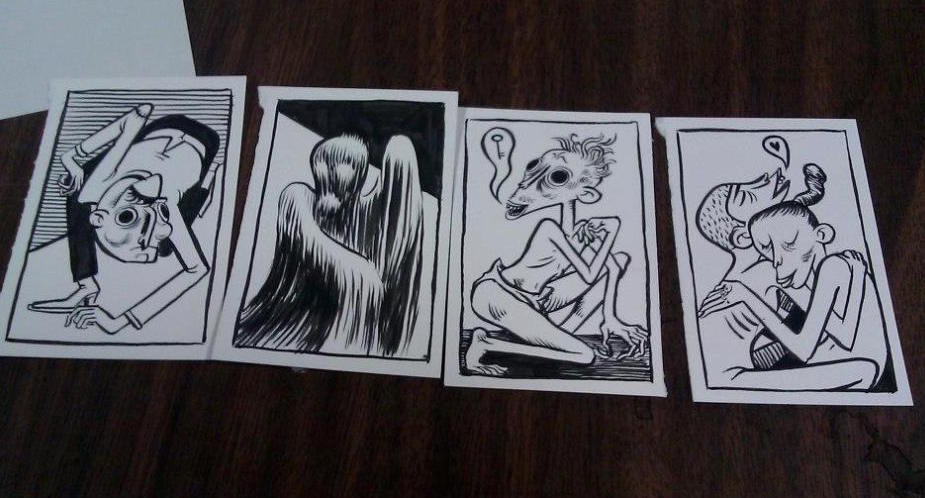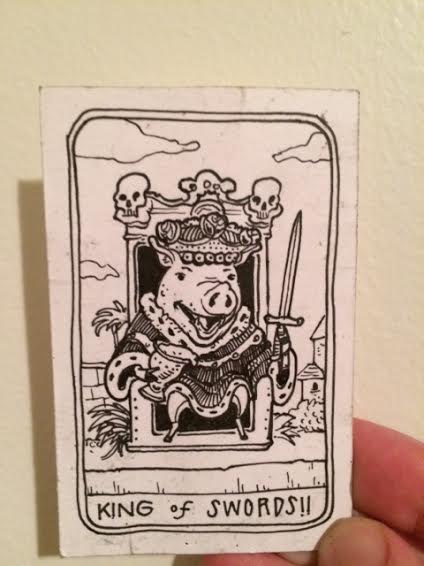The following on how to make your own tarot cards is adapted from D.I.Y Magic: A Strange & Whimsical Guide to Creativity, published by Penguin Books.
It is ironic that those of us who seek to explore consciousness, to shift our perception, and to expand our reality, often rebel against much of mainstream thought, and yet we treat our own sacred cows as unquestionable dogma. I am referring to magic and the occult in all of its traditional forms—for too many seekers the practice of magic remains something academic, a museum piece kept behind the red velvet rope and sealed display case glass. From a safe distance we gaze at the bygone practitioners of yore: the Kabbalah, the Golden Dawn, the Gnostics, the alchemists, (insert your favorite brand of the occult here) etc., instead of trying to develop ideas that are fresh and contemporary.
Introducing D.I.Y. Magic
I believe it is time to try approaching magic with a fresh perspective. This is what I have attempted to do in my new book D.I.Y. Magic— it is a collection of recipes, spells, and techniques meant to be experienced not studied. What is magic if we play with it outside of any context? What is magic in its raw form? I expect this take on magic might piss some people off, and hopefully delight some people as well! It is meant to be messy and fun; an activity, not an artifact. As Erik Davis, author of Techgnosis recently said to me, “D.I.Y. Magic represents a really significant change that is going on, the stripping away of a lot of the balderdash and exotica from esoteric and magical practices and the reformulating of them for a more immediate, hands-on, consciousness-hacking kind of approach.”
But rather than going on about the rhetoric behind my approach, I think it best to give you an example. In the following excerpt from D.I.Y. Magic, I suggest that you try making up your own tarot cards. Now, don’t get me wrong, I mean no disrespect to the traditional study of tarot cards! They really do work. But for the beginner (or the advanced practitioner who wants to approach things with beginner’s mind), here is a freeing and fun way to dive into the process of tarot without all of the rules and well-trod pathways.
This experiment asks you to tap into your intuition and imagination—into magic in its raw and undeveloped form. If traditional tarot is something historically accurate, fancy, and complex, like a recipe for duck liver confit or escargot, then think of D.I.Y. Magic as being about just making yourself a damn peanut butter and jelly sandwich. D.I.Y. Magic consists of 36 recipes that are playful, hands-on, and slightly careless with tradition. Here is a sample of that kind of magic:
How to Make Your Own Tarot Cards
While to this day I have a great deal of respect for the traditional tarot cards, I insist there is nothing mysterious about how they work, and the same powerful insights and empathetic revelations can occur using a deck of cards with your own homemade symbols. While the traditional tarot deck is very well balanced and chock full of powerful archetypal symbols, there is nothing inherently supernatural going on, and for this reason I think that making your own deck can give you a better understanding of not only how archetypes and symbols work but also how card readings work, and even how the traditional tarot works. The traditional tarot deck is but one book, yet an infinity of books wait to be written.
I was inspired to create my own tarot deck by looking at the images from a Mexican tablas de lotería board hanging on my kitchen wall (brightly colored pictures on individual squares of la luna, la mano, el borracho, el corazón; fifty-four in all). I realized they could be just as useful in telling a person’s fortune as the tarot, if not more so, because they are not cramped by the accumulation of centuries of interpretations. I started experimenting with these images, and pretty soon I was making up my own. Sadly, I can’t draw worth a hill of beans (in fact I can’t even draw a hill of beans) but even stick figures and sloppy sketches will get the job done. If you can actually draw, then it’s even more fun. I have workshopped this idea with comic book artists, and they have come up with really amazing and beautiful cards.
With a little experimentation, it is simple to construct a full deck using whatever symbols you want, a deck that you, the practitioner, can modify to suit your own preferences and tastes. The personalized deck should have that much more potency. It can be tweaked and tailor made, it doesn’t come out of a box but from the deck maker’s thoughts; each will be as unique as the individuals who made them.
Steps to Create Your Tarot Deck
These are the steps to creating your own tarot deck, but remember there ain’t no hard-and-fast rules.
Make Your List of Tarot Cards
To begin, make your own list of cards. Fifty-four is a good number to shoot for. Even though technically a proper tarot deck has seventy-eight cards, you can start out with fewer. You can calibrate a deck of cards from scratch that will suit you individually as a fortune-teller, or you can use this short list of basic archetypes to get you started. Feel free to use any of these that you like; it is also of course fine to steal ideas from the original tarot deck or the tablas de lotería. You just want cards that are archetypal.
- New Jersey
- The Pulled-Pork Sandwich
- Walt Disney
- The Earthquake
- Mercy
- Beer
- The Knife
- The Mermaid
- The Businessman
- The Guitar Player or Troubadour
- The Gangster
- The Corrupt Politician
- The Polar Bear
- The Ghost
- Mr. Whiskers
- The Falcon
- The Dreamer
- The Alligator
- The Crow
- Florida
- The Hammock
- The Sea
- The Dancer
Create Your Cards
Once you’ve decided on what to include, it’s time for the pack of blank index cards. (Regular blank white paper works just as well, too. You just have to do more work with the scissors.) On each card, draw one image from your list. The picture can be as simple or complex as you want; generally more detail is more helpful. Glue the images to a deck of regular playing cards. This makes them easier to shuffle.
Practice with Your Tarot Cards
Now you’re ready to tell somebody’s fortune. It’s best to practice on yourself a few times before moving on to friends and eventually the biggest challenge—strangers.
Here is a simple layout and some tips to get you started. The easiest layout is known as the Celtic cross. You place one card in the middle, and then one card above it, one below it, and one each to the left and the right of your center card, five cards in all. You can place them face down and explain what the positions signify before flipping them over. The center card represents the present. The card to the left, the past, and the card to the right, the future. The lower card represents that which is hidden, the higher card signifies outward influences. There are dozens of other traditional ways to do the layout, some of them quite complicated. I recommend checking out a book or two from the library if you want to go deeper with studying the tarot. This is one case where it is better to skim a handful of books on the subject, rather than read deeply from just one, because they will all offer slightly different interpretations, and it is best to grasp the ideas behind the symbols from multiple vantage points. Like cooking or playing guitar, once you are familiar with the basics you should feel free to improvise.
Interpreting Your Tarot Cards
How you actually interpret the cards takes practice. They are symbols. Pretend you are a Jungian analyst parsing the content of a dream. Read into everything. Think out loud as you go and ask questions of your audience to see if you’re on the right track. The skeptic will see this as cheating because the skeptic is a knuckle-head, too obtuse to separate the concrete from the abstract. People like this are boors and best avoided all together.
Magic works via power of imagination. Imagination works by metaphor. Let us say you have dealt a card with a picture of a bird drawn on it. What does that image bring to mind in the context of the other cards that have been dealt, and in the context of its position in the spread, and in the context of the person’s fortune who you are reading? For example, a bird brings to mind flight, perhaps a symbol of freedom or rising above a situation, but in conjunction with a card depicting the ocean, it might connote travel overseas. It is important to understand that a tarot reading is a collaboration between the fortune-teller and the subject. It should not be a guessing game. If you are having trouble reading the cards, the solution is to simply ask your subject for help. Just ask, What were you doing yesterday? What were you doing last week? What has been on your mind lately? How do you feel about the question you asked? It is very helpful to ask basic questions like these; once you know the history of your subject, all of the symbols on the cards will fall into place.
Interpreting tarot symbols, whether the traditional or home- made, is very similar to interpreting dreams. If the meaning laid out in the symbols is not immediately clear it is simply because more information is needed. A dream, or a tarot reading, becomes clear if the details are filled in. All these things should come into play, but ultimately it is about a feeling, not a set of rules. If used properly, the cards will allow you to tap into powerful intuitions that you would not have been aware of otherwise.


















